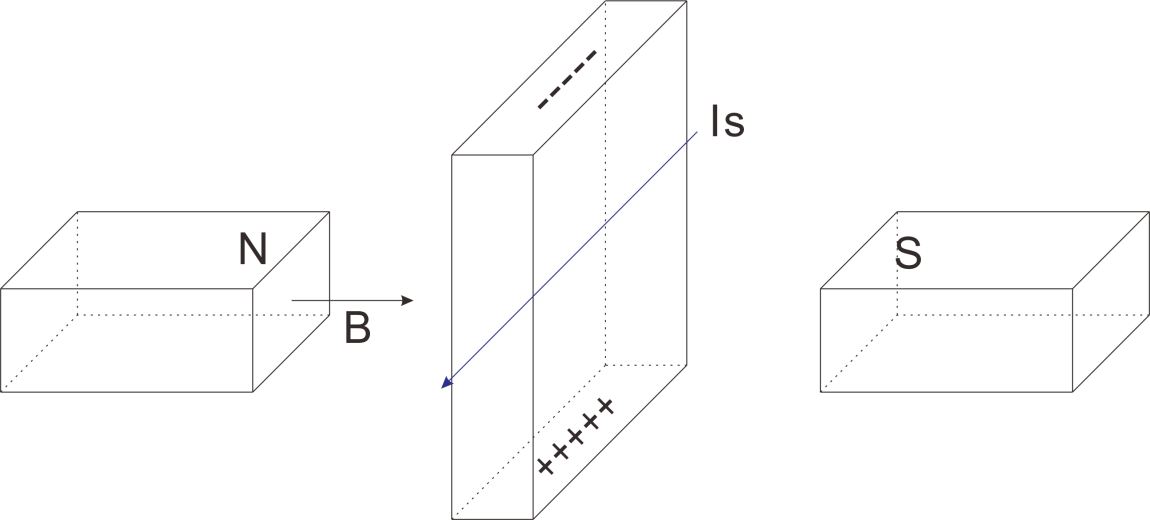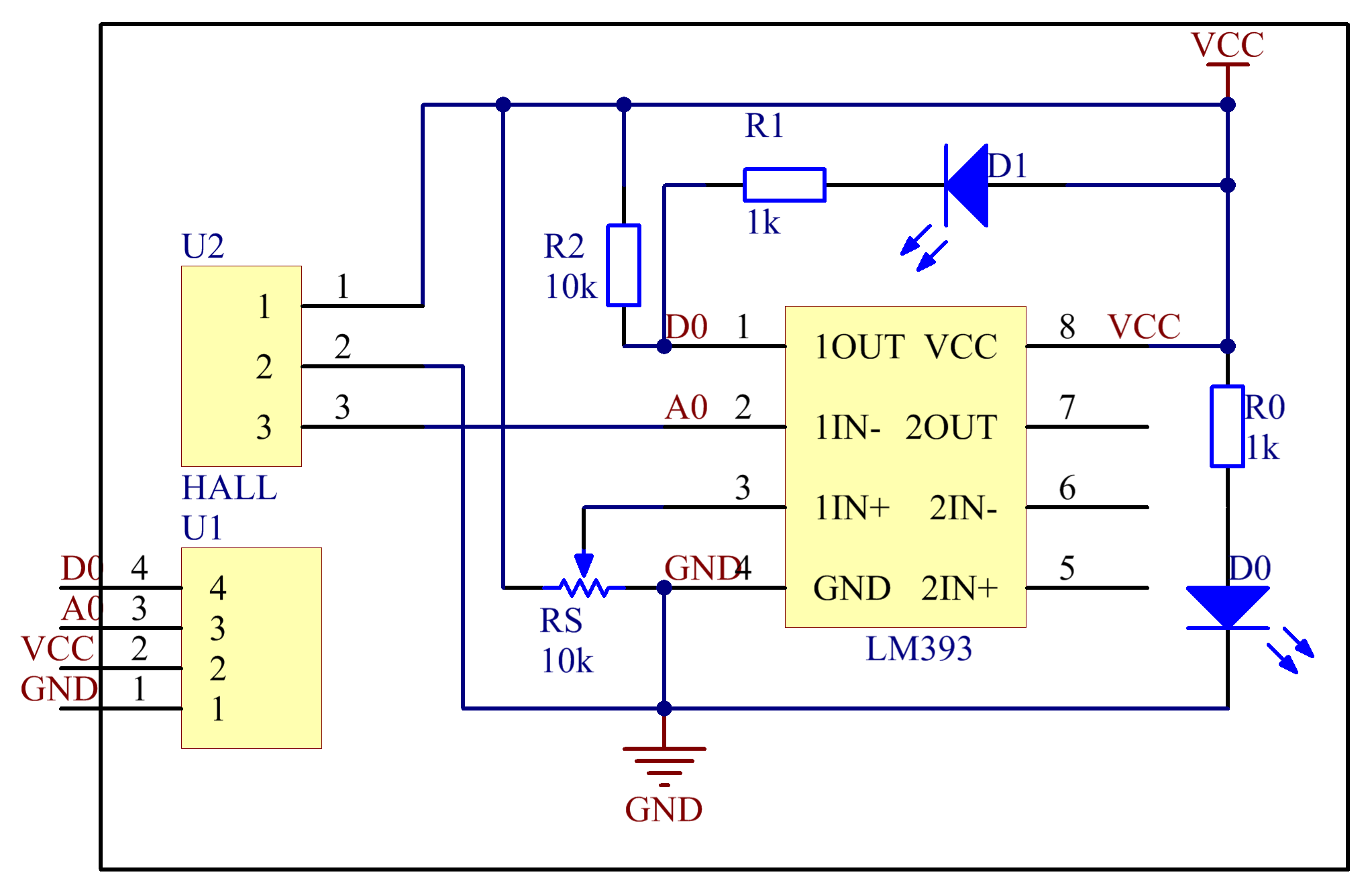Introduction
Based on Hall Effect, a Hall sensor is a one that varies its output voltage in response to a magnetic field. Hall sensors are used for proximity switching, positioning, speed detection, and current sensing applications.
Hall sensors can be categorized into linear (analog) Hall sensors and switch Hall sensors. A switch Hall sensor consists of voltage regulator, Hall element, differential amplifier, Schmitt trigger, and output terminal and it outputs digital values. A linear Hall sensor consists of Hall element, linear amplifier, and emitter follower and it outputs analog values. If you add a comparator to a linear (analog) Hall sensor it will be able to output both analog and digital signals.

Components
– 1 * Raspberry Pi
– 1 * Breadboard
– 1 * Network cable (or USB wireless network adapter)
– 1 * Analog Hall Switch module
– 1 * Dual-color LED module
– 1 * Switch hall module
– 1 * PCF8591
– 2 * 3-Pin anti-reverse cable
– 1 * 4-Pin anti-reverse cable
– Several Jumper wires (M to F)
Experimental Principles
Hall Effect
Hall Effect is a kind of electromagnetic effect. It was discovered by Edwin Hall in 1879 when he was researching conductive mechanism about metals. The effect is seen when a conductor is passed through a uniform magnetic field. The natural electron drift of the charge carriers causes the magnetic field to apply a Lorentz force (the force exerted on a charged particle in an electromagnetic field) to these charge carriers. The result is what is seen as a charge separation, with a buildup of either positive or negative charges on the bottom or on the top of the plate.

Hall Sensor
A Hall sensor is a kind of magnetic field sensor based on it.
Electricity carried through a conductor will produce a magnetic field that varies with current, and a Hall sensor can be used to measure the current without interrupting the circuit. Typically, the sensor is integrated with a wound core or permanent magnet that surrounds the conductor to be measured.
The schematic diagram of the analog Hall sensor module:

The schematic diagram of the Switch hall module:

Experimental Procedures
For switch Hall sensor, take the following steps.
Step 1: Build the circuit
| Raspberry Pi | Switch Hall Module | Raspberry Pi | Dual-color LED Module | |
| GPIO0 | SIG | GPIO1 | R | |
| 5V | VCC | GND | GND | |
| GND | GND | GPIO2 | G |

For C language users:
Step 2: Change directory
cd /home/pi/SunFounder_SensorKit_for_RPi2/C/17_switch_hall/
Step 3: Compile
gcc switch_hall.c –lwiringPi
Step 4: Run
sudo ./a.out
For Python users:
Step 2: Change directory
cd /home/pi/SunFounder_SensorKit_for_RPi2/Python/
Step 3: Run
sudo python 17_switch_Hall.py
Put a magnet close to the Switch Hall sensor. Then a string “Detected magnetic materials” will be printed on the screen and the LED will light up.

For Analog Hall Switch, take the following steps
Step 1: Build the circuit
| Raspberry Pi | PCF8591 Module | Analog Hall Switch |
| SDA | SDA | * |
| SCL | SCL | * |
| 3V3 | VCC | VCC |
| GND | GND | GND |
| GPIO0 | * | DO |
| * | AIN0 | AO |

For C language users:
Step 2: Change directory
cd /home/pi/SunFounder_SensorKit_for_RPi2/C/17_analog_hall_switch/
Step 3: Compile
gcc analog_hall_switch.c –lwiringPi
Step 4: Run
sudo ./a.out
For Python users:
Step 2: Change directory
cd /home/pi/SunFounder_SensorKit_for_RPi2/Python/
Step 3: Run
sudo python 17_analog_hall_switch.py
Now “Current intensity of magnetic field : xxx ” will be displayed on the screen. Put the magnet close to the analog Hall sensor, with the north magnetic pole towards the sensor, and then ” Magnet: North.” will be displayed. Move the magnet away, and ” Magnet: None.” will be printed. If the magnet approaches the sensor with the south magnetic pole towards it, ” Magnet: South.” will be printed on the screen.
Note: Pin D0 of the Analog Hall Sensor will output “0” only when the south pole of the magnet approaches it, otherwise it will output “1”.

C Code
Analog Hall
#include <stdio.h>
#include <wiringPi.h>
#include <pcf8591.h>
#define PCF 120
int main (void)
{
int res, tmp, status;
wiringPiSetup ();
// Setup pcf8591 on base pin 120, and address 0x48
pcf8591Setup (PCF, 0x48);
status = 0;
while(1) // loop forever
{
res = analogRead(PCF + 0);
printf("Current intensity of magnetic field : %d\n", res);
if (res - 133 < 5 || res - 133 > -5)
tmp = 0;
if (res < 128) tmp = -1;
if (res > 138) tmp = 1;
if (tmp != status)
{
switch(tmp)
{
case 0:
printf("\n*****************\n" );
printf( "* Magnet: None. *\n" );
printf( "*****************\n\n");
break;
case -1:
printf("\n******************\n" );
printf( "* Magnet: North. *\n" );
printf( "******************\n\n");
break;
case 1:
printf("\n******************\n" );
printf( "* Magnet: South. *\n" );
printf( "******************\n\n");
break;
}
status = tmp;
}
delay (200);
}
return 0 ;
}Switch Hall
#include <wiringPi.h>
#include <stdio.h>
#define HallPin 0
#define Gpin 1
#define Rpin 2
void LED(char* color)
{
pinMode(Gpin, OUTPUT);
pinMode(Rpin, OUTPUT);
if (color == "RED")
{
digitalWrite(Rpin, HIGH);
digitalWrite(Gpin, LOW);
}
else if (color == "GREEN")
{
digitalWrite(Rpin, LOW);
digitalWrite(Gpin, HIGH);
}
else
printf("LED Error");
}
int main(void)
{
if(wiringPiSetup() == -1){ //when initialize wiring failed,print messageto screen
printf("setup wiringPi failed !");
return 1;
}
pinMode(HallPin, INPUT);
LED("GREEN");
while(1){
if(0 == digitalRead(HallPin)){
delay(10);
if(0 == digitalRead(HallPin)){
LED("RED");
printf("Button is pressed\n");
}
}
else if(1 == digitalRead(HallPin)){
delay(10);
if(1 == digitalRead(HallPin)){
while(!digitalRead(HallPin));
LED("GREEN");
}
}
}
return 0;
}Python Code
Analog Hall
#/usr/bin/env python
import RPi.GPIO as GPIO
import PCF8591 as ADC
import time
def setup():
ADC.setup(0x48)
def Print(x):
if x == 0:
print ''
print '*************'
print '* No Magnet *'
print '*************'
print ''
if x == 1:
print ''
print '****************'
print '* Magnet North *'
print '****************'
print ''
if x == -1:
print ''
print '****************'
print '* Magnet South *'
print '****************'
print ''
def loop():
status = 0
while True:
res = ADC.read(0)
print 'Current intensity of magnetic field : ', res
if res - 133 < 5 and res - 133 > -5:
tmp = 0
if res < 128:
tmp = -1
if res > 138:
tmp = 1
if tmp != status:
Print(tmp)
status = tmp
time.sleep(0.2)
if __name__ == '__main__':
setup()
loop()Switch Hall
#!/usr/bin/env python
import RPi.GPIO as GPIO
HallPin = 11
Gpin = 12
Rpin = 13
def setup():
GPIO.setmode(GPIO.BOARD) # Numbers GPIOs by physical location
GPIO.setup(Gpin, GPIO.OUT) # Set Green Led Pin mode to output
GPIO.setup(Rpin, GPIO.OUT) # Set Red Led Pin mode to output
GPIO.setup(HallPin, GPIO.IN, pull_up_down=GPIO.PUD_UP) # Set BtnPin's mode is input, and pull up to high level(3.3V)
GPIO.add_event_detect(HallPin, GPIO.BOTH, callback=detect, bouncetime=200)
def Led(x):
if x == 0:
GPIO.output(Rpin, 1)
GPIO.output(Gpin, 0)
if x == 1:
GPIO.output(Rpin, 0)
GPIO.output(Gpin, 1)
def Print(x):
if x == 0:
print ' ***********************************'
print ' * Detected magnetic materials *'
print ' ***********************************'
def detect(chn):
Led(GPIO.input(HallPin))
Print(GPIO.input(HallPin))
def loop():
while True:
pass
def destroy():
GPIO.output(Gpin, GPIO.HIGH) # Green led off
GPIO.output(Rpin, GPIO.HIGH) # Red led off
GPIO.cleanup() # Release resource
if __name__ == '__main__': # Program start from here
setup()
try:
loop()
except KeyboardInterrupt: # When 'Ctrl+C' is pressed, the child program destroy() will be executed.
destroy()
